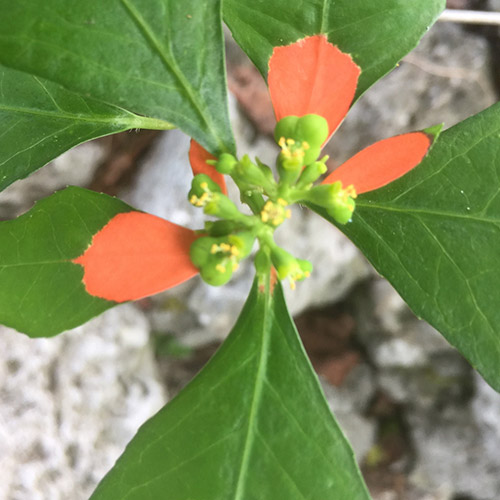📷 Joanne Celinski, plants.ces.ncsu.edu
Euphorbia cyathophora aka 🔥Fire On The Mountain
Euphorbia | Updated: February 15, 2025
Euphorbia cyathophora, or Fire On The Mountain, is native to North and South America. It has a Cyathium inflorescence with a convex axis. This annual herb grows up to 3 feet tall, with green stems and lobed leaves, often found near disturbed sites.
Quick Guide
- Full sun to partial shade 🌤️
- Typical water needs for a succulent
- Plant grows up to 3′ (0.9 m) tall
- Zones 8a to 11
- Not cold hardy
- Propagation by seeds and stem cuttings
- Can be toxic to humans and animals
- Winter Dormant
How to 🩷 Care for and Propagate Your 🪴 Succulents
General Care for Euphorbia cyathophora aka Fire On The Mountain
Euphorbia cyathophora thrives in full sun to partial shade, requiring at least 6 hours of direct sunlight daily for optimal growth.
Soil
It prefers well-drained sandy soils but can tolerate a range of soil types, including clay and loam. The soil pH can be acidic, neutral, or alkaline.
Water
This plant has typical water needs for a succulent, meaning it should be watered when the soil is dry. Avoid overwatering to prevent root rot.
Temperature
Suitable for USDA Zones 8A–11, Euphorbia cyathophora is not cold hardy and should be protected from frost. It can survive temperatures as low as 30°F (-1.1°C) but may die back in colder climates.
Maintenance
This plant is relatively high maintenance due to its potential to become weedy. It can self-seed aggressively, so it’s important to monitor and control its spread in the garden. The milky sap is toxic and can cause skin irritation, so handle with care.
Pests and Diseases
Generally resistant to pests, but the plant’s milky sap can irritate the digestive tracts of herbivores. It can attract bees, butterflies, and flies, making it a good choice for a pollinator-friendly garden.
How to Propagate Euphorbia cyathophora aka Fire On The Mountain
Seeds
- Collect seeds from the three-lobed capsules that form after flowering.
- Sow the seeds directly in well-draining soil. Seeds can be challenging to start but will self-seed easily once established.
- Keep the soil consistently moist until germination occurs, typically in warm conditions.
Stem Cuttings
- Cut a healthy stem segment using a clean, sharp knife or scissors.
- Allow the cutting to dry for a day or two to form a callus over the cut surface.
- Plant the cutting in a pot filled with well-draining soil.
- Water sparingly, just enough to keep the soil slightly moist.
- Place the pot in a location with bright, indirect sunlight until roots develop, which usually takes a few weeks.
Propagation is most successful during the plant’s active growing season, typically in spring and summer.
Tags & Attributes
Scientific Classification
Kingdom: Plantae
Clade: Tracheophytes
Clade: Angiosperms
Clade: Eudicots
Clade: Rosids
Order: Malpighiales
Family: Euphorbiaceae
Genus: Euphorbia
Species: E. cyathophora


